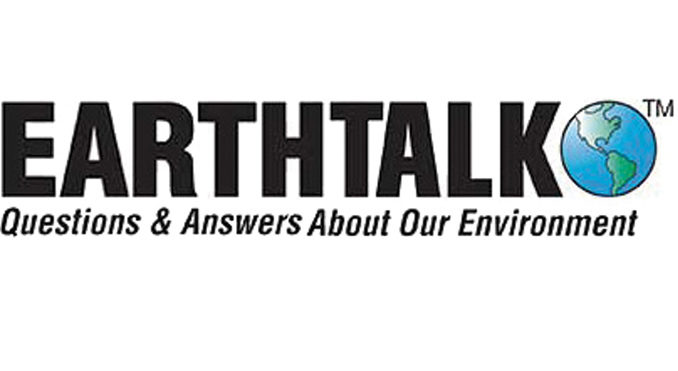
Dear EarthTalk: What is the Count Us In campaign all about and how does it differ from other efforts to help us rein in carbon emissions? ~ P. Stout, Anchorage, AK

Count Us In is a global movement of people and organizations committed to getting individuals to take active, reasonable steps to lower their own carbon footprints so that the actions of many aggregate into significant change on a large scale. The goal of the non-profit campaign is to get this message out to upwards of a billion people, especially the so-called “non-activist middle” that simultaneously have the most business and political sway but are also actively contributing to carbon pollution.
Individuals can get on board with Count Us In via the organization’s website by engaging in various carbon footprint reduction “steps” that are counted by an online “Aggregator” designed to show how individual efforts add up to significant carbon reductions collectively. Each step has an associated description for an action to be taken, anything from driving an electric car to improving the insulation of your home, as well as a respective carbon reduction value. When you take a “step,” you input the data associated with the action you took, then that step is added to the Aggregator. To date, the Aggregator has recorded over 15 million individual steps, which adds up to a savings of some 174 million kilograms of greenhouse gas.
With over 100 organizations standing behind the movement, including TED Countdown, The United Nations Environment Programme (UNEP), Accenture, Global Citizen, World Wildlife Fund (WWF), the European Union (EU) Climate Pact, YouTube and SKY Sports, the Count Us In campaign has gained a serious reputation as a worthwhile effort in climate change activism, encouraging its followers to join in the action. According to their official website, the Count Us In campaign utilizes the significant influence that these large organizations have to act as a catalyst for change. As they state in their FAQ, “Your organization or company can help Count Us In become the largest citizen climate action mobilization, by joining as a partner, and promoting Count Us In among your supporters, followers, members, staff and customers.”
Count Us In considers itself different from other climate action movements because organizers encourage participants to actively, rather than passively, engage in carbon reductions with their community. Each participant must take action in the form of a “step,” and then record that step appropriately within the Aggregator. This simple, yet effective step-by-step process pushes people to be aware of not only the action they are taking and the impact they have as an individual, but also the cumulative effect the community’s actions have when added together.
If you’d like to take a “step” with the Count Us In community, their team makes it easy for you by providing 16 of their best steps, chosen specifically because of three criteria: “their impact on your personal carbon pollution, their power to influence leaders and their ability to involve everyone.”
Here are some popular Count Us In steps you can take right now: fly less often, drive electric, insulate your home, wear clothes that last, tell your politicians, walk/cycle more, cut food waste, green your money, repair and reuse, and get some solar! Make sure to enter your progress into the Aggregator so your contributions are counted.
Dear EarthTalk: What’s new in food packaging to make it more sustainable? ~ E.C., Bern, NC
Along with food waste, food packaging is a significant source of pollution, generating approximately half of the packaging waste in the United States. In the wake of growing concerns about climate change and food product packaging’s role in it, companies are taking action to make packaging more sustainable.
There are many changes in progress. Corn and cane sugar plants are being increasingly used as materials for packaging food. However, this system puts pressure on already-stressed agricultural land and can jeopardize food security, since crops that could be used for food itself are being used for other purposes. One solution is to use agro-food residue, the byproduct of agricultural production—cornstarch, rice husks, etc. that would otherwise be discarded—for food packaging. In this way, packaging can reduce agricultural material waste without threatening agriculture or food resources.

Companies have begun taking the whole life cycle of a product’s packaging, beyond just use and disposal, into consideration. In doing so, they have prompted designs of products made from and transported using sustainable materials, not just ones that can be recycled by customers. For example, Heinz is working with Pulpex to prototype a food-grade bottle made from sustainably-sourced wood pulp that can be recycled and biodegrades if it is thrown away. It has a 90 percent lower carbon footprint than glass and a 30 percent lower footprint than PET, a very common type of plastic in food packaging.
Other examples abound. Alter Eco worked with Natureflex to create truffle wrappers that are made from eucalyptus and birch and then lined with aluminum. The material reportedly composts in industrial settings and biodegrades in the ocean. Boxed Water is Better sells water in recyclable boxes, made of 75 percent paper that is flatten so efficient for shipping, allowing one truck to carry as many boxes to filling centers as 26 trucks carrying plastic bottles. The company also ensures that the paper comes from well-managed forests, that the material is free of BPAs and other chemicals, and that part of the profit is invested in planting trees in deforested and fire-prone areas. Mondelez, which produces snacks like Oreos, and Wheat Thins, Ritz and Belvita crackers, has almost reached its goal of reducing its use of virgin plastic by 25 percent for rigid packaging and by five percent overall by 2025.
Such technologies are creating more effective food packaging that reduce waste, but these solutions face obstacles. Investing in sustainable materials and partnering to develop new ideas, combined with the supply chain and inflation disruptions associated with the pandemic, come with potentially-prohibitive financial costs that have impeded some planned transitions. Also, demonstrating the benefits of these changes has proven to be difficult, and “greenwashing”—marketing that overstates companies’ products’ environmental pluses—has made investors wary. However, the chances of success are significant as growing numbers of customers demand sustainable packaging. For example, 24 percent of young adults have indicated a willingness to pay five percent more for sustainably packaged food.
EarthTalk® is produced by Roddy Scheer & Doug Moss for the 501(c)3 nonprofit EarthTalk.
See more at https://emagazine.com. To donate, visit https//earthtalk.org.
Send questions to: question@earthtalk.org.

